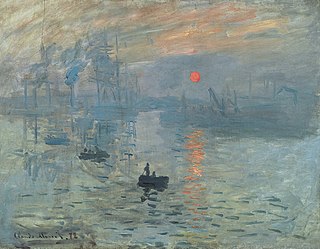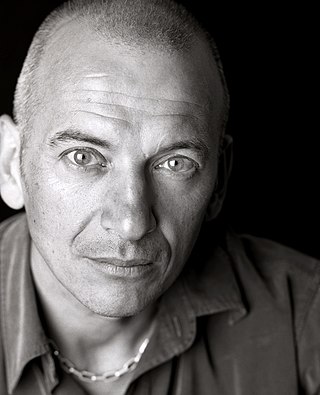Related Research Articles

Édouard Manet was a French modernist painter. He was one of the first 19th-century artists to paint modern life, as well as a pivotal figure in the transition from Realism to Impressionism.

Impressionism was a 19th-century art movement characterized by relatively small, thin, yet visible brush strokes, open composition, emphasis on accurate depiction of light in its changing qualities, ordinary subject matter, unusual visual angles, and inclusion of movement as a crucial element of human perception and experience. Impressionism originated with a group of Paris-based artists whose independent exhibitions brought them to prominence during the 1870s and 1880s.

The Boston Globe, also known locally as the Globe, is an American daily newspaper founded and based in Boston, Massachusetts. The newspaper has won a total of 27 Pulitzer Prizes. The Boston Globe is the oldest and largest daily newspaper in Boston and tenth-largest newspaper by print circulation in the nation as of 2023.

The Pulitzer Prize for Criticism has been presented since 1970 to a newspaper writer in the United States who has demonstrated 'distinguished criticism'. Recipients of the award are chosen by an independent board and officially administered by Columbia University. The Pulitzer Committee issues an official citation explaining the reasons for the award.

Post-Impressionism was a predominantly French art movement that developed roughly between 1886 and 1905, from the last Impressionist exhibition to the birth of Fauvism. Post-Impressionism emerged as a reaction against Impressionists' concern for the naturalistic depiction of light and colour. Its broad emphasis on abstract qualities or symbolic content means Post-Impressionism encompasses Les Nabis, Neo-Impressionism, Symbolism, Cloisonnism, the Pont-Aven School, and Synthetism, along with some later Impressionists' work. The movement's principal artists were Paul Cézanne, Paul Gauguin, Vincent van Gogh and Georges Seurat.

Lucian Michael Freud was a British painter and draughtsman, specialising in figurative art, and is known as one of the foremost 20th-century English portraitists. He was born in Berlin, the son of Jewish architect Ernst L. Freud and the grandson of Sigmund Freud. Freud got his first name "Lucian" from his mother in memory of the ancient writer Lucian of Samosata. His family moved to England in 1933, when he was 10 years old, to escape the rise of Nazism. He became a British naturalized citizen in 1939. From 1942 to 1943 he attended Goldsmiths' College, London. He served at sea with the British Merchant Navy during the Second World War.

Luncheon of the Boating Party is an 1881 painting by French impressionist Pierre-Auguste Renoir. Exhibited at the Seventh Impressionist Exhibition in 1882, it was identified as the best painting in the show by three critics. It was purchased from the artist by the dealer-patron Paul Durand-Ruel and bought in 1923 from his son by industrialist Duncan Phillips, who spent a decade in pursuit of the work. It is now in The Phillips Collection in Washington, D.C. It shows a richness of form, a fluidity of brush stroke, and a flickering light.

The Foundation E. G. Bührle Collection is an art museum in Zürich, Switzerland. It was established by the Bührle family to make Emil Georg Bührle's collection of European sculptures and paintings available to the public. The museum is in a villa adjoining Bührle's former home. In 2021 many works were exhibited on 20-year loan in almost a whole floor of the new extension of the Kunsthaus Zürich museum. There was controversy due to suspicions that many works were looted from Jews by Nazi Germany. The foundation was managed for decades by Bührle's son Dieter, who was sentenced to a conditional prison term of 8 months in 1970 for supplying weapons to the racist apartheid regime in South Africa.
Ty Burr is an American film critic, columnist, and author who currently reviews films for The Washington Post and writes the film and popular culture newsletter "Ty Burr's Watchlist". Burr previously served as film critic at The Boston Globe from 2002 until 2021.

Wesley Morris is an American film critic and podcast host. He is currently critic-at-large for The New York Times, as well as co-host, with J Wortham, of the New York Times podcast Still Processing. Previously, Morris wrote for The Boston Globe, then Grantland. He won the 2012 Pulitzer Prize for Criticism for his work with The Globe and the 2021 Pulitzer Prize for Criticism for his New York Times coverage of race relations in the United States, making Morris the only writer to have won the Criticism prize more than once.

Phil Grabsky is a British documentary film-maker.

Acquavella Galleries is an art gallery located at 18 East 79th Street between Madison and Fifth Avenues in the Upper East Side neighborhood of Manhattan, New York City.

The 2011 Pulitzer Prizes were announced on Monday, April 18, 2011. The Los Angeles Times won two prizes, including the highest honor for Public Service. The New York Times also won two awards. No prize was handed out in the Breaking News category. The Wall Street Journal won an award for the first time since 2007. Jennifer Egan's A Visit From the Goon Squad picked up the Fiction prize after already winning the 2010 National Book Critics Circle Award. Photographer Carol Guzy of The Washington Post became the first journalist to win four Pulitzer Prizes.

Marlborough Fine Art was founded in London in 1946 by Frank Lloyd and Harry Fischer. In 1963, a gallery was opened as Marlborough-Gerson in Manhattan, New York, at the Fuller Building on Madison Avenue and 57th Street, which later relocated in 1971 to its present location, 40 West 57th Street. The gallery operates another New York space on West 25th Street, which opened in 2007. It briefly opened a Lower East Side space on Broome Street.

Dance at Bougival is an 1883 oil-on-canvas painting by the French artist Pierre-Auguste Renoir, currently in the collection of the Museum of Fine Arts in Boston, Massachusetts, United States. Described as "one of the museum's most beloved works", it is one of three in a collection commissioned by Paul Durand-Ruel. It depicts a scene in the French village of Bougival, about 15 km from the center of Paris, a site utilized by many Impressionists besides Renoir including Claude Monet, Alfred Sisley, and Berthe Morisot.
Rudolf Staechelin was a Swiss businessman and art collector. He is considered one of the major Swiss collectors of the first half of the 20th century.

The Boston Irish Famine Memorial is a memorial park located on a plaza between Washington Street and School Street in Boston, Massachusetts. The park contains two groups of statues to contrast an Irish family suffering during the Great Famine of 1845–1852 with a prosperous family that had immigrated to America. Funded by a trust led by Boston businessman Thomas Flatley, the park was opened in 1998. It has received contrasting reviews and has since been called "the most mocked and reviled public sculpture in Boston".

Black Woman with Peonies also known as Négresse aux pivoines,Young Woman with Peonies, or Negress with Peonies, is a pair of paintings created by the French Impressionist painter Frédéric Bazille in the spring of 1870. Both paintings are oil on canvas, with one version on display at the National Gallery of Art in Washington, D.C. and the other on view at the Musée Fabre in Montpellier, France. The dimensions of both paintings are 60.3 cm × 75.2 cm.
The Brigadier is a 2004 oil on canvas painting by the British artist Lucian Freud (1922–2011). It is a larger than life seven foot high portrait of Andrew Parker Bowles. In 2015 the work sold at auction at Christie's in New York City for $34.89 million.

A Couple also known as The Engaged Couple or Alfred Sisley and his Wife, is an oil-on-canvas painting by the French artist Pierre-Auguste Renoir (1841–1919), created around 1868 during his early Salon period at a time when he focused on thematic works about couples. It was acquired by the Wallraf–Richartz Museum in 1912.
References
- ↑ "2011 Pulitzer Prizes". www.pulitzer.org. Retrieved 8 February 2018.
- ↑ "Globe art critic Sebastian Smee wins Pulitzer", Boston Globe website Archived 19 April 2011 at the Wayback Machine
- ↑ WashPostPR (8 November 2017). "Sebastian Smee joins The Post's Features team" . Retrieved 8 February 2018– via www.WashingtonPost.com.
- ↑ "2011 Pulitzer Prize Criticism Biography", Pulitzer Prize website
- ↑ "Sebastian Smee biography", Boston Globe website
- ↑ "2011 Pulitzer Prize Criticism Citation", Pulitzer Prize website Archived 16 September 2012 at the Wayback Machine
- ↑ Capps, Kriston (13 October 2015). "Why Everyone (Possibly Including God) Hates Renoir". The Atlantic. Archived from the original on 16 December 2015. Retrieved 23 December 2019.
- ↑ Smee, Sebastian. "Review | More and more people loathe Renoir. Is it time for a revival?". The Washington Post. Retrieved 23 December 2019.
- ↑ Cooke, Rachel (16 October 2016). "The Art of Rivalry by Sebastian Smee review – from shared vision to slashed canvas". The Guardian. Retrieved 26 November 2016.
- ↑ The New York Times review
- ↑ The Washington Post review
- ↑ Smee, Sebastian (November 2018). "Net Loss: The Inner Life in the Digital Age". Quarterly Essay (72). Retrieved 11 December 2018.